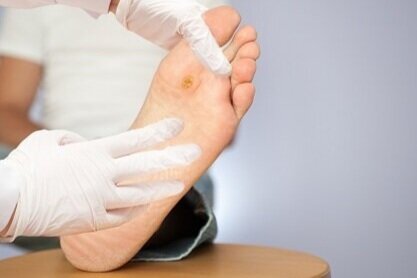FOOT WARTS
WHAT IS A PLANTAR WART?
It is a hard, grainy growth that typically manifests on the underside of the foot, particularly in regions where the most pressure is absorbed during walking or standing.
This uncomfortable condition arises when the human papillomavirus (HPV) comes into contact with the skin on the soles of the feet, particularly when the virus infiltrates the body through tiny cuts, abrasions, or vulnerable openings on the underside of the foot.
TYPES OF PLANTAR WARTS
Because they are spread through viral infections, those with weakened immune systems — such as children and senior citizens — are more likely to develop these warts. While most warts are visible, some warts grow inwards — due to too much pressure — and form a callus.
The two most prevalent varieties of warts found on the soles of the feet are:
Solitary wart
When there is just one single wart that increases in size and may develop into additional “satellite” warts.
Mosaic wart
In some cases, multiple warts cluster together in one area—these warts are usually more difficult to treat.
PLANTAR WARTS SYMPTOMS
While most cases of warts can go away on their own with time, most people want faster relief. The goal of podiatric treatment for this condition is to completely remove the wart, not cover it up. Common warning signs include:
Small, fleshy, and rough growths develop
Hard, thickened skin forms
Formation of small clotted blood vessels
Pain when walking or standing
Tenderness in the affected area
Your doctor can usually diagnose it by completing a simple physical exam. He or she may remove a section of the lesion to send out for further testing.
PLANTAR WARTS TREATMENT
If walking becomes painful or the warts are spreading, there are over-the-counter treatments available — though these often require multiple treatments and are still ineffective. When self-care and home remedies fail, visit your podiatrist. Your doctor may recommend these conservative, non-invasive treatments:
Prescription-strength wart medications
Cryotherapy (freezing the wart off)
Immune therapy
Minor surgery to cut away the wart
Laser treatment
If you think you have one or more warts, make an appointment today to have them removed before they multiply.
CORNS & CALLUSES
WHAT ARE CORNS AND CALLUSES?
When there is too much friction or pressure on your feet for extended periods of time, the skin will harden to protect itself — this is when corns & calluses begin to form. Friction occurs when something repeatedly comes into contact with part of the foot.
Uneven pressure, on the other hand, arises when your body weight is not distributed evenly across your feet. It's important to note that both friction and uneven pressure are often attributed to the consequence of making ill-fitting shoe choices, which can exacerbate these foot conditions.
Corns and calluses are very similar in how they form — the skin on the foot becomes thick and rough to the touch. The thickened skin eventually becomes dead tissue, and the layer underneath becomes irritated.
This irritation causes pain when pressure is applied to the affected area. However, they do form in different areas of the foot — corns are found on the toes, while calluses form on the bottom of the foot.
CORNS AND CALLUSES CAUSES
While there is not just one cause of these conditions, poor shoe choice is thought to be the main reason they develop. Examples of ill-fitting shoes include:
Shoes that are too tight or pinch the toes
High-heeled shoes that unevenly distribute weight
Shoes that are too loose and do not fit properly
Shoes that do not provide proper arch support
In addition to poor shoe choice, there are other foot conditions that contribute to the development of it — like hammertoe. Those who have foot deformities may also be at a higher risk of developing corns & calluses.
DIAGNOSIS AND CORNS AND CALLUSES TREATMENT
Following a physical examination of the foot, your podiatrist should be able to diagnose your condition. Simply changing your shoes and being more mindful of how shoe choice affects your feet can usually clear up and prevent mild corns & calluses.
Your podiatrist may also recommend the following home remedies to eliminate it:
Padding
To protect the area where the corn is located, you can use small pads that shield the area from friction.
Massage
Rubbing corns & calluses following a shower with a pumice stone or a callus file to eliminate the thickened skin.
Larger corns and calluses may have to be surgically reduced. Your podiatrist will use a blade to carefully shave away the thickened or dead skin — similar to how a pumice stone works, but much more effective. The procedure is painless and is usually completed on an outpatient basis. A cortisone injection may also be used to reduce pain caused by it.
Book an appointment with the Foot and Ankle Center today.
TOENAIL FUNGUS
WHAT IS IT?
Also called onychomycosis or tinea unguium — it is an infection below the surface of the nail caused by contact with different types of fungi. Nail fungus usually begins with white or yellow spots under the tip of the toenails.
If left untreated, the infection can grow deeper, which can cause the nail to become weak or brittle to the point that it eventually falls off.
COMMON TYPES OF FUNGAL NAIL INFECTIONS
In general, there are four types of fungal infections that affect the toes. These include:
Distal subungual onychomycosis (DSO)
It is the most commonly diagnosed and treated fungal infection. Also known as Athlete’s Foot, this infection spreads across the nail bed, which causes the nail to become discolored and weak.
White superficial onychomycosis (WSO)
Far less common than Athlete’s Foot, WSO causes white patches to appear across the entire nail.
Candida onychomycosis
This chronic fungus is usually caused by trauma, and it causes the toenails to become bulbous or enlarged.
Proximal subungual onychomycosis (PSO)
This fungal infection causes yellow or white spots to appear near the base of the toenail.
TOENAIL FUNGUS SYMPTOMS
Because there are varying types and levels of severity, it’s important to have your condition diagnosed by a podiatric physician. If you are worried that you might be suffering from a fungal infection in your nails, perform a self-evaluation to look for the following common symptoms:
Scaling under the nail
Distorted nail
White or yellow streaks on the nail
Foul odor from the infected nail
Crumbling corner or tip of the nail
Flaking white areas on the toenail’s surface
Loss of the nail
WHAT IS THE RECOMMENDED FUNGAL NAIL INFECTIONS TREATMENT?
Treatment isn’t always necessary — depending on the severity of your condition — but it is recommended simply because it might be contagious. Not only can you spread the condition to someone else, but depending on the type of fungus, it can also spread to infect your other toes.
For mild cases, your doctor will likely start with conservative treatments. These may include prescription anti-fungal oral medications or topical solutions.
For patients who exhibit severe symptoms — or for those who do not respond to medication — the doctor may recommend nail avulsion surgery. During this procedure, the nail plate is removed, and chemical treatments are introduced to treat the infection.
Contact us for more information or to schedule a consultation.
INGROWN NAILS
These are nails whose corners or sides dig painfully into the skin, often causing infection. They are frequently caused by improper nail trimming but also by shoe pressure, injury, fungus infection, heredity, and poor foot structure.
Toenails should be trimmed straight across, slightly longer than the end of the toe, with toenail clippers.
The common symptoms are the following:
Inflammation
Pain
Redness
Swelling
Drainage
If they become painful or infected, contact our podiatry team at Foot & Ankle Centers.
Our Podiatrists may remove the ingrown portion of the nail, and if the condition reoccurs frequently, we may permanently remove the nail.
If you have an ingrown nail, don't be afraid to schedule an appointment. Your treatment will be gentle and virtually painless, and we'll get you back to your normal activities right away.





